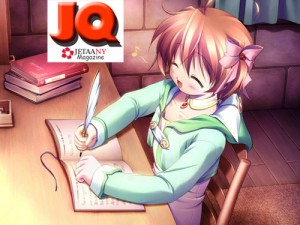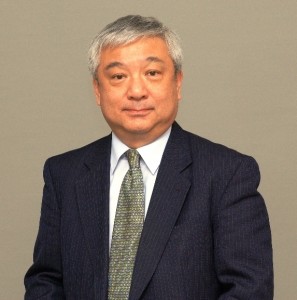JET Alum Helps Moss Point Mississippi High School Host Japanese Students for Cultural Exchange
Via WLOX.com. Posted by Kay Monroe (Miyazaki-shi, 1995 -97). Click here to join the JETwit Jobs Google Group and receive job listings even sooner by email.
————————————————————————————————————
Moss Point High School’s Japanese club hosted 30 Japanese students in Moss Point Mississippi for a unique experience through the Kizuna Project with JET Alum Megan Bernard.
WLOX.com – The News for South Mississippi
JQ Magazine: JQ&A with Jenn Doane of the Hiroshima Ange Violet
![20Jennifer[1]](http://jetwit.com/wordpress/wp-content/uploads/2012/10/20Jennifer11.jpg)
“On JET I was deeply involved in both my town and my prefecture, and in turn developed close relationships with both foreigners and Japanese people. Seattle is a diverse place, but I don’t think I would ever have had such a dynamic and interesting life outside of my day job!”
Seattle native Jenn Doane (Shimane-ken, 2010-12) has played soccer since she was eight years old. Having been a four-year starter on her high school varsity team, a three-year starter in college, and selected to play for the Olympic Development Program, she is now the first American to play professional soccer on a Japanese team, the Hiroshima Ange Violet. JQ learned all about her path to the team in this exclusive interview.
How did you become interested in Japan and the JET Program?
I have known about the JET Program since I was young, actually—my parents were both very involved in the Japanese community in Seattle: My mother was the executive director of the Japan America Society and the Japanese American Chamber of Commerce, and my dad served as president of the Society as well, and I think they have even been asked to be interviewers for prospective JET candidates. However, as any teenager would, I wasn’t interested in anything my parents were! I am three-fourths Japanese and one-fourth Caucasian (my mom is full, my dad is half, and both were born and raised in America).
I wasn’t necessarily ashamed of being Japanese, but I grew up in a mostly Caucasian suburb–and while I don’t think I was ever really picked on or anything, being Japanese wasn’t something I was overly proud of! You should have seen the reactions of my friends when I sometimes brought onigiri and kamaboko in my school lunch!
I was planning to be a Spanish major in college until my junior year when I decided to switch my focus to Japanese and study abroad in Osaka. I think I finally came around and got more curious about my heritage and the Japanese language. Many students from my college (Whitman) do the JET Program, and after a wonderful study abroad experience and hearing from all the raving alums, I thought it would be the perfect thing to do after graduating. So, here I am (or rather, there I was…).
I noticed you were a violinist for the Whitman Women’s Symphony. Any plans to continue with the violin in Japan?
Unfortunately, I have not touched a violin in a long time—however, I really have a passion for music and have found other ways to realize the musician in me! I joined a singing group in the countryside (we sing all the Glee hits) and have also been learning guitar. If I had easier access to a violin, I would definitely love to get back into it!
If you don’t mind sharing, what was it like to be on JET and teach at schools during the time of the disasters last year?
Compared to the JETs and teachers actually living in Tohoku, I can’t say that things were dramatically different. However, there was a kind of solemnness in the air after what happened— lots of moments of silence, and donations boxes all around school and town. One of my college friends is a JET in Miyagi Prefecture and we couldn’t get a hold of him for two weeks after the earthquake…it was terrifying. Thankfully, he had been at a relief shelter without Internet or phone access.
I also had the opportunity to volunteer in one of the hardest hit towns of Tohoku (Kesennuma) about six months after the tsunami, just helping sort debris and cleaning ruined houses, and it was such a moving experience—I met some incredibly strong and inspiring people, people who lost loves ones, everything they owned, or both.
JQ Magazine Seeks Writers for Winter 2012!
As winter approaches, JETAA New York’s JQ magazine continues to provide content with an ever-expanding array of articles, interviews and features (see our recent stories here). We’re now looking for new writers, including recent returnees and JET vets, from all JETAA chapters worldwide for posting stories via our host at the global JET alumni resource site JETwit.com. (Scribes are also encouraged to join the JET Alumni Writers group on LinkedIn.)
Below are story ideas grouped by JET participants and alumni (JET World) and those more on Japanese culture (Japan World). And if you’re a JET or JETWit contributor from anywhere in the world with a story idea of your own, let us know!
Click “Read More” below for our winter 2012 ideas pitch package, and contact JQ editor Justin Tedaldi (magazine [at] jetaany [dot] org) to sign up for stories.
Justin’s Japan: New York Comic Con Welcomes ‘Sakuran’ Creator Moyoco Anno
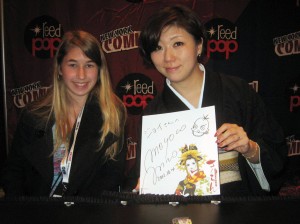
Manga author Moyoco Anno with New York Comic Con attendee Joy Charbonneau of Pacifica, CA, Oct. 14, 2012. (Justin Tedaldi)
By JQ magazine editor Justin Tedaldi (CIR Kobe-shi, 2001-02) for Examiner.com. Visit his Japanese culture page here for related stories.
Anime and manga fandom came out in full force at New York Comic Con last weekend, with a record 116,000 fans visiting the Jacob K. Javits Center for the annual event. Sunday (Oct. 14) hosted special guest artist Moyoco Anno of Sugar Sugar Rune and Sakuran fame.
A professional mangaka (manga artist and author) and one of the most respected names in Japanese comics today for her josei (ladies’) comics, Anno was in town to promote the recently released English-language edition of Sakuran, a starkly drawn tale of Japanese courtesans in the Edo period.
“We’d been thinking about publishing Sakuran for a few years now, and were finally able to convince [our] CEO to take the plunge,” said Ed Chavez, marketing director of Vertical Inc., the book’s North American publisher, which had its own booth at Comic Con. Based in New York, Vertical translates Japanese works of fiction and non-fiction that are considered good reads with universal themes from its vibrant book market.
Standouts of Vertical’s manga stable include Osamu Tezuka’s Buddha, Usamaru Furuya’s No Longer Human and Kanata Konami’s Chi’s Sweet Home.
For the complete story, click here.
JQ Magazine: Book Review – ‘The Buddha in the Attic’
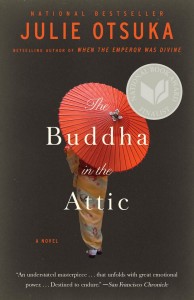
“Just the right length, the perfect amount of general and specific, and no solid story but yet the story that so many people in the United States—and elsewhere—can tell about hope, and heartbreak, and the ways in which lives change that most of us never intend or imagine.” (Knopf)
By Liz Mathews (Hiroshima-ken, 2005-06) for JQ magazine. Liz is the JETAA New York Book Club wrangler.
I would like to start by saying that the JETAANY Book Club discussed reading Julie Otsuka’s The Buddha in the Attic for at least five months before choosing it for our fall meeting. This is notable because 1) we were right in our primary reason for putting it off; and 2) we were even more right in finally selecting it to read. It’s easy to explain the first note: Over the summer we thought it best to opt for a lighter, more beachy read, and not a novel about Japanese “picture brides” and their distressing existences in the United States of the early 20th century.
As for the second point, autumn and its colder, shorter, darker days did turn out to be a much more appropriate setting to read Otsuka’s carefully composed novel. Otsuka wrote her book in eight sections, writing mostly from the perspective of the women—the women as a united “we”—who came across the ocean to a new life of false promises, how they endured meeting their husbands the first time, how they got along (or didn’t) with their employers and new fellow countrymen, and what happened as a new, Japanese American generation grew.
For all the suffering in those first five sections, there is hope written between the lines. Hope for a new life with a wonderful husband, hope that hard work will pay off in acceptance, and hope for their children in that, as one of the paragraphs ends, “Whatever you do, don’t end up like me.” But then, as one club member put it, “You come to this country, you work your ass off, you think you’re getting somewhere…and then you don’t” (referring to the war’s outbreak).
When we got together to discuss The Buddha in the Attic, we spent a fair amount of time talking about the perspective the story was written from—first person plural—and how initially we didn’t like it, but then either grew accustomed to it or could at least appreciate it as a tool. One attendee stated, “Everyone’s situation is different. You can’t even generalize the Japanese experience.” Another pointed out, “[Otsuka] has a new story in every sentence.” We laughed a little at this realization, probably as all our thoughts turned back to our own departure orientations, when we were constantly told those very same things.
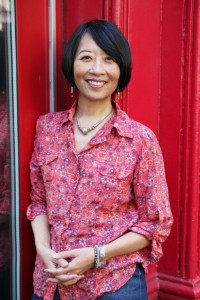
“From the very beginning I saw Gordon Hirabayashi’s story as a unique and quintessentially American story, and although he was Japanese American himself, I hoped that the play would have a broad appeal, not just for that community, or just the Asian American community, but for people of all ages, ethnicities, and walks of life.” (Lia Chang)
By Ann Chow (Hyogo-ken, 2007-09) for JQ magazine. Ann is a native New Yorker who gets scared of the big, scary world, but ventures out into it anyway. She coined the term “stealth gaijin” (or thinks she did because she hadn’t heard of it before writing a bunch of articles under that moniker during her time on JET). When not portraying 14-year-olds on Gossip Girl, she can sometimes be found playing a (much older) law clerk on Law and Order: SVU.
Jeanne Sakata is an award-winning stage actress who has performed with many well-known companies on the country’s biggest stages, including the Lincoln Center Theater and the John F. Kennedy Center. She made her playwriting debut in 2007 with Hold These Truths (formerly Dawn’s Light: The Journey of Gordon Hirabayashi), the story of the Japanese American activist and Presidential Medal of Freedom winner, who passed away earlier this year at age 93.
Hold These Truths first premiered in 2007, and has been performed multiple times around the country since then. It is now a part of the Library of Congress Playwrights Archive in the Asian American Pacific Islander Collection in Washington, D.C., and is now having its Epic Theatre Ensemble New York premiere run (starring Joel de la Fuente and directed by Lisa Rothe) through Nov. 18 at the Theater at the 14th Street Y in repertory with Dispatches from (A)mended America.
JQ recently spoke with Sakata about her profound fascination with Hirabayashi’s life, the meticulous research that went into writing Hold These Truths, and what she hopes the play will accomplish.
What are the goals you are trying to achieve with Hold These Truths?
I hope, first, that Hold These Truths will spread awareness of Gordon Hirabayashi, whose story is still virtually unknown to so many Americans. As a young college student during World War II, Gordon stood up for the principles of the Constitution when the United States government failed miserably to do so, persecuting and imprisoning him for his actions. Earlier this year, Gordon passed away in January at the age of 93, and, amazingly, a few months later in April, President Obama posthumously awarded him the Presidential Medal of Freedom, the nation’s highest civilian honor, for the courageous stand he took so many decades ago. So I feel, this year especially, that Gordon’s story is a vitally important one to anyone who cares about our country, and the principles of the Constitution. Second, I hope the play will spread awareness on the East Coast of the mass incarceration of all people of Japanese ancestry during World War II on the West Coast, as knowledge of this tragedy seems to be much less prevalent here than out west.
In general, people on the West Coast know more about this time in American history. What reactions do you expect now that it’s playing here in New York?
As I said earlier, one common reaction we’ve had is that of shock that something so horrible happened during the World War II years in America. Many of our East Coast audience members who lived through those years have said that they were aware that “something bad” happened to the Japanese on the West Coast during that time, but they did not know just how bad it was. For example, they did not know that anyone in Seattle who was one-sixteenth Japanese, or babies from orphanages who had any Japanese blood, were ordered to be penned up behind barbed wire. They don’t know that so many children and young American citizens were torn out of their schools and imprisoned, and for so many years. But I also hope the reaction to Gordon’s story we’ve had here so far will continue—that people will be delighted, as well as profoundly moved and inspired, to learn about him.
How did you choose the subject matter for the play? Did you have family that lived in the internment camps?
I myself am a third-generation Japanese American, and in the 1990s I happened to see a documentary video about Gordon titled A Personal Matter: Gordon Hirabayashi vs. the United States. I was shocked that I had never heard his story before, and I started to find out everything I could about him. The more I read, the more fascinated and intrigued I became. The story just grasped me and wouldn’t let me go, becoming an obsession, and I knew I couldn’t rest until I tried to write a play about Gordon.
My mother’s side of the family was living in Colorado during World War II, and so did not have to go to the camps, although they experienced plenty of hostility and racism in the town where they lived. My father’s family, however, all lived in Watsonville on California’s West Coast, so all of them were rounded up and imprisoned in the camp in Poston, Arizona. As I was growing up, my father and aunts and uncles never spoke of the experience, I believe, because it was so traumatic for them, as it was for so many others.
Roland Kelts Praises the Who’s Pete Townshend in ‘The New Yorker’
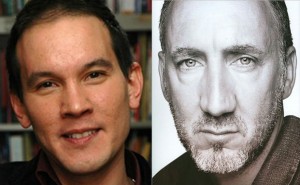
Roland Kelts, left: “When I published my first book, Japanamerica, about the odd synchronicity between two societies, Japanese and American, at once at great odds and suddenly allies, my publisher asked me to send the book to Pete Townshend. He had asked for it, why not give it to him?”
Courtesy of JETAA Northern California’s Mark Frey (Kumamoto-ken, 2002-06):
In a new article by JET alum Roland Kelts (Osaka-shi, 1998-99) on Pete Townshend in The New Yorker, Kelts references his book Japanamerica—of which Townshend said “I love that book!” to JQ magazine editor Justin Tedaldi at an NYC signing yesterday for his new memoir Who I Am—at the end of the article and offers some thoughts contrasting the experience of artists in the U.K. and Japan after World War II.
I first met Pete Townshend fifteen years ago in a modest London hotel suite. I was there with my friend Larry David Smith to interview Townshend for Smith’s book, “The Minstrel’s Dilemma.” We were already seated inside when I looked out the first-floor window and saw Townshend pulling into the parking lot.
He arrived alone, sans entourage or fanfare, driving himself in a gray Mercedes station wagon. Minutes later, the knob on the suite door rattled and shook. I stood, thinking that it might be a member of the hotel staff and wondering if I should turn the knob from our side. There was a pause, then more rattling, then the door swung open and Townshend burst through, eyes wide with exertion. He had apparently been trying to pull when he should have pushed.
We were scheduled to meet for two hours, but Townshend was unstoppable, regaling us not with stories of rock debauchery, but a stream of complex, sometimes half-formed ideas about popular culture, history, and human psychology. We were told not to ask him about his failing marriage; he immediately addressed it, confessing to a jolt of sadness while shaving that morning. “Don’t mention Keith Moon,” wrote his personal assistant via fax. “I never properly mourned for Keith,” he soon said, unprompted, and through tears.
For the complete story, click here.
Justin’s Japan: Nippon in New York: Days of Comic Con, Nights of Provocation
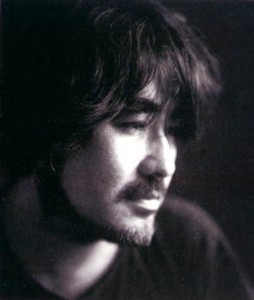
Legendary artist Yoshitaka Amano (“Final Fantasy,” “Vampire Hunter D”) will appear at New York Comic Con Oct. 12-13.
By JQ magazine editor Justin Tedaldi (CIR Kobe-shi, 2001-02) for Examiner.com. Visit his Japanese culture page here for related stories.
October is shaping up to be a memorable month for Japanese culture in New York. Whether it’s examples of its rich past (traditional Shinto dance), something contemporary (legendary manga and anime artists), or works of art captured by others (photographer Eikoh Hosoe, a play based on the life of a Japanese American Medal of Freedom winner), autumn here is so inviting.
Wednesday, Oct. 10, 6:30 p.m.
333 East 37th Street
Master photographer Eikoh Hosoe is known for his dark, metaphorical and provocative images. First emerging in postwar Japan as a member of the avant-garde movement, he produced Barakei (Ordeal by Roses), featuring author and right-wing activist Yukio Mishima in a series of dark, erotic poses. He later published Kamaitachi, showing butoh dance founder Tatsumi Hijikata in a series of supernatural images across the Japanese countryside. Mr. Hosoe speaks about his collective work and reflects on his long and dynamic career. Moderated by Dr. Miwako Tezuka, director of Japan Society Gallery. Followed by a reception.
Oct. 11-14
655 West 34th Street
First held in 2006 and paired with New York Anime Festival starting in 2010, New York Comic Con is the city’s biggest annual fan convention dedicated to comics, graphic novels, anime, manga, video games, toys, movies and television. Attendance has more than tripled since its launch, as last year’s estimates topped 105,000 visitors. This year’s distinguished “anime guests” include Final Fantasy/Vampire Hunter D artist extraordinaire Yoshitaka Amano (Oct. 12-13), Sakuran creator Moyoco Anno (Oct. 13-14), Tufts University Professor of Japanese Studies Susan Napier (Oct. 13), and perennial NYCC staple voice actress Veronica Taylor (Pokémon, Teenage Mutant Ninja Turtles).
For the complete story, click here.
JQ Magazine: Autumn in Nagasaki
By Mohan Nadig (Hyogo-ken, 1998-99) for JQ magazine. Mohan currently lives in Tokyo.
A word of advice: If you haven’t been to Nagasaki, go.
Since my time as a JET in Hyogo Prefecture in 1998, I’ve been on something of a mission to visit every prefecture in Japan at least once. Last year, one of the remaining spots high on my list was Nagasaki.
I’d planned to visit on several occasions in the past but never made it–I was finally inspired to book a ticket after reading David Mitchell’s fascinating novel The Thousand Autumns of Jacob de Zoet, which is set in the region at the turn of the 19th century.
The timing of my visit last October turned out to be very fortuitous. A friend from Nagasaki told me that I would be there during the Okunchi Festival and that a friend of hers would be able to show me around town.
Upon arriving in Nagasaki by train from Fukuoka, the first thing that struck me about the city center was its amazing ugliness, which is of the “what could they possibly be thinking?” variety. I was hard pressed to find a corner not marred by some rusting hulk, dilapidated structure or tacky signage left over from the 1970s. For a city with such a significant history, the lack of beautification and preservation efforts is stunning.
Fortunately, I very quickly found a wealth of redeeming features: hospitable people, nuggets of history waiting to be discovered around every corner, and fantastic views of the sea–and of course, the festive atmosphere of Okunchi.
Justin’s Japan: NYC Gives B’z an A at Best Buy Theater
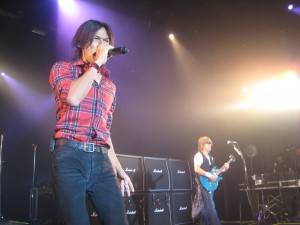
Koshi Inaba, left, and Tak Matsumoto of B’z played a sold out show at New York’s Best Buy Theater Sept. 30, 2012. (Justin Tedaldi)
By JQ magazine editor Justin Tedaldi (CIR Kobe-shi, 2001-02) for Examiner.com. Visit his Japanese culture page here for related stories.
“You’re not going to stand there the whole time, are you?” a thirtysomething asks me in Japanese from behind the photo pit barrier.
I tell her that I wouldn’t be much of a rock photographer if I stood still the whole time.
“Good,” she says, her face all business. “Because we lined up for this from yesterday morning. So please try to keep your head down, because it’s in my way.”
Welcome to the Best Buy Theater in Manhattan, which drew a sold out Sunday crowd of over 2,000 on Sept. 30 for the New York concert debut of B’z, Japan’s all-time biggest band. Since 1988, Tak Matsumoto and Koshi Inaba have sold over 80 million records, and hold an untouchable record for consecutive number one singles in their native land (46 and counting). A colossal achievement in music, to be sure, but how would the rockers be received on this, their first-ever coast to coast North American tour?
For the complete story, click here.
For Justin’s September 2012 interview with Tak and Koshi, click here.
JQ Magazine: Book Review – ‘Salvation of a Saint’
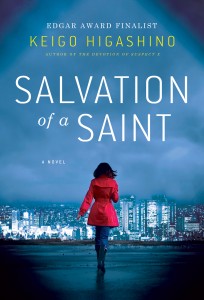
“The detectives in ‘Salvation’ are in constant motion, interrogating suspects, racking their brains for a break in the case. Insomniacs, they observe, question and theorize with an obsessive resolve, as good fictional crime detectives are apt to do.” (St. Martin’s Press)
By Sharona Moskowitz (Fukuoka-ken, 2000-01) for JQ magazine. Sharona is interested in fresh, new voices in fiction and creative nonfiction.
(Click image for an exclusive sample from the audiobook)
With more twists and turns than a mountain route through the Japanese Alps, Keigo Higashino’s latest murder mystery Salvation of a Saint is a seamless, well-constructed suspense novel with all the elements of a classic murder mystery, though he adds considerable fizz to the formula with a few unconventional characters and a very unlikely murder technique.
Yoshitaka is the unfortunate victim, poisoned early on in the story by arsenic laced coffee which he drinks with tepid oblivion. Despite being offed so soon, throughout the novel we learn quite a bit about him as his character is constructed in fragments that piece together to tell the story of his life.
And what an unsavory fellow indeed.
Narcissistic, duplicitous and with a chauvinistic tendency to view women solely in terms of their reproductive potential, Yoshitaka is not terribly likeable, to put it mildly. During the time of his murder he was in the process of leaving his wife Ayane because of her inability to bear him a child, a fact which he states openly with unabashed grandiosity. He was also, conveniently for the plot, in the midst of an affair with Ayane’s trusted confidant and apprentice Hiromi.
So whodunit? Was it a crime of passion committed by one of Yoshitaka’s jilted lovers past or present? Perhaps a jealous colleague? Or were Ayane and Hiromi secretly in cahoots?
JQ Magazine: JQ&A with The Inaka Founder Chris Allison

“Japan’s inaka offers something completely different. In the inaka you can find nature restaurants, shops, and people that will do a much better job representing a different culture and a different experience—an experience you can only get in Japan.”
By Sarah Rogers-Tanner (Kyoto-fu, 2009-11) for JQ magazine. Sarah hails from Afton, Minnesota and learned a thing or two about the inaka in her small town of Ujitawara, located in the mountains outside of Kyoto City. While there, Sarah taught students ages 2-15 and is now pursuing her master’s degree in elementary inclusive education at Teachers College, Columbia University.
Chris Allison (Oita-ken, 2009-12) is a recent JET returnee who spent three years teaching at both an academic high school, as well as a rural, agricultural school. Originally from a small town in Indiana, Chris studied international business and Chinese at Bethel College and began studying Japanese while on JET. Though he is in the U.S. for the time being, Chris hopes to soon be back in Asia again, this time teaching English in Beijing.
Over the past few years, Chris noticed the need for a website that, as opposed to focusing on the prefecture as a whole, exhibits what each town in Japan has to offer. Chris founded The Inaka so that foreigners living in Japan can share pictures and information about their towns for future generations of ALTs and tourists alike. Chris hopes to bring tourism not only to the larger cities but also to the small towns that many of us JET alumni came to love.
Chris says that by increasing the tourism to these towns and cities, we also increase the breadth of knowledge that the world has about Japan, allowing us to give something back to our second home abroad. Now, The Inaka needs your help. The upload process is very easy, so take a look at your prefecture and see what you can contribute!
What made you fall in love with the inaka?
This is slightly off topic a bit, but I often get asked, “What is there to see in Japan?” Up until recently, I didn’t really know how to answer this question. For most countries it is a fairly simple question. For China, “Great Wall.” For France, “Eiffel Tower.” Japan doesn’t really have that one thing that makes it stand out. Sure you could say something like Tokyo or Kyoto, but those are cities and not single attractions.
There was never one thing that I could say that I felt gave a fair representation of Japan. Then it hit me. I could not think of one specific place or attraction, because the entire country is filled with them. No matter what town you go to, you will find heaps of history and sights that will amaze you. The inaka is what makes Japan stand out as a country; it is where you will find the history, nature and culture of what I have come to know as the real Japan. I think it makes the country worth traveling to.
That is why I love the inaka!
JETAA British Columbia Newsletter – September 2012
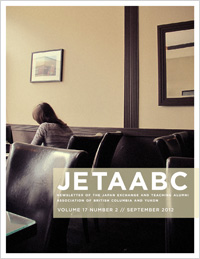
The latest issue of the JETAABC Newsletter is now available. In this “Food Issue”, they talk about making Chicken Namban, preparing bentos for lunch in a reasonable amount of time, fermenting your own natto, eating locally-produced food, checking out various izakaya restaurants in Vancouver, and much more!
- PDF (25Mb): http://www.jetaabc.ca/wp-content/uploads/2012/09/NewsletterV17N2.pdf
- Online viewer version on Issuu.com at http://issuu.com/jetaabc/docs/newsletterv17n2
Justin’s Japan: Shinichi Nishimiya, Former Japanese Consul-General in New York, Dies in Tokyo
By JQ magazine editor Justin Tedaldi (CIR Kobe-shi, 2001-02) for Examiner.com. Visit his Japanese culture page here for related stories.
Shinichi Nishimiya, the newly appointed Japanese ambassador to China, died today (Sept. 16) at a Tokyo hospital, government sources said. The incoming envoy previously served as the Consul-General of Japan in New York from March 2009 to the end of 2010, becoming Japan’s deputy foreign minister in charge of economic affairs prior to his new appointment.
Nishimiya, 60, collapsed near his home in Tokyo and was hospitalized on Thursday, only two days after becoming the top envoy to China. The cause of his death has yet to be known. According to Reuters, doctors were looking into the cause of death, but no other details were available. Police have ruled out the possibility of foul play.
Born in 1952, Nishimiya studied at the University of Tokyo and joined the foreign service of Japan in 1976. After working at the Embassies in Washington, D.C., Moscow and London, he served as the director of policy coordination division, Foreign Policy Bureau and as deputy director-general, Asian and Oceanian Affairs Bureau, both in Tokyo. From 2005 to 2006, he served as a as consul at the Japanese embassy in Beijing.
In his new role, Nishimiya would return to Beijing to replace Uichiro Niwa, his predecessor from the private sector, amid deterioration in bilateral ties sparked by Japan’s nationalization of the Senkaku Islands.
For the complete story, click here.
JQ Magazine: Inside the JETAA New York Book Club

The JETAA New York Book Club with August’s selection, “The Thousand Autumns of Jacob de Zoet” by David Mitchell.
By Greg Anderson, (Fukuoka-ken, 1990-92) for JQ magazine. Greg is part of the fourth class of the JET Program, which began in 1987. He is currently employed as an auditor with the U.S. Treasury Department and is a new member of the JETAA New York Book Club.
Gone are the amazing, fascinating, fast-paced days of life in Japan filled with culture shock. As JET alums, most of us are employed in vocations that have no connection to Nippon at all. Ask yourself this question: After you have successfully completed another week or day at work, what do you have to look forward to? If you’re job hunting, then you have experienced another week of success/failure, but next week holds new opportunities. If you have children, you can look forward to screaming demanding creatures that we all love but sometimes drive us crazy. If you don’t have children, you may have an annoying spouse, boyfriend or girlfriend who has never been to Japan, has no interest in Japan, and wishes that you would get over your preoccupation with it and grow up. Once a JET, always a JET!
The JET experience transforms all who participate in the program; you will never be the same again. What can you do when you miss the connection to Japan? Besides going to Sapporo Ramen (located on 152 West 49th Street), you can attend a JET book club meeting. Every other month, JET alumni and others interested in Japan get together to discuss a Japan-related book over a nice relaxing glass of wine, soda, or water (but feel free to bring your choice of beverage). It does not end there! The hors d’oeuvres provided are smashing, and at a mere two to three dollars are a better bargain than McDonald’s. Participants also have the option of bringing goodies to supplement the menu, and you never know what surprises to expect.
The book club was started about three years ago, by two enterprising JET alums, Jessica Langbein and Michael Glazer, who suggested that JETAANY should have a book club. In fact, when the club first started, the meetings were held at the home of another JET, Katrina Barnas. The genesis of the book club was neither Japan nor the JET Program, but began as a college major. Jessica was a Japanese literature major in college and as a JET alumna was seeking some literature that would pique her interest. It was suggested to her that she speak to fellow alumnus Michael, and over a cup of coffee the JETAANY Book Club was born. Facebook was used to recruit new members.

